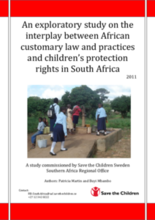The Southern Africa Regional Office of Save the Children Sweden commissioned a review of the National Child Protection Systems in South Africa, Swaziland and Zambia. The review found evidence that customary, cultural and religious practices impact on the strength of child protection systems; that some of these practices strengthen and some of the them tend to weaken National Child Protection Systems in the countries in question. Save the Children Sweden commissioned this follow-up study to explore these observations in further detail; to explore to what extent in South Africa, African customary law and practice promotes and/or inhibits the protection of children; how the positive impacts can be harnessed for the greater protection of more children; how the negative impacts can be mitigated; and finally how and who should be at the helm of any necessary developments of African customary law.
This study recognises that these questions are relevant to a wide range of religious and cultural practices, not just African customary law. In South Africa, Muslim law, Christianity and cultural practices within the traditional Afrikaans communities for example, have likewise been noted to afford both protection and create risks for children. Ideally a study of this nature would engage in identifying and analysing practices across the full socio-cultural range. Unfortunately the scope of the budget and time available for the study made a comprehensive study of this nature impossible. A choice was made to start the inquiry by considering the interplay between African customary law and practices and children’s protection rights with the objective of encouraging similar inquiries, within a similar framework constructed during the course of this study, covering all other relevant religious and cultural systems.
This study focuses on the interplay between African custom and the following protection domains:
- Customary upbringing and parenting practices and community protection mechanisms
- Gender sensitive practices and attitudes
- Children’s health, including their sexual health and wellbeing
- Criminal offences by and against children
- Status and participation of children.

